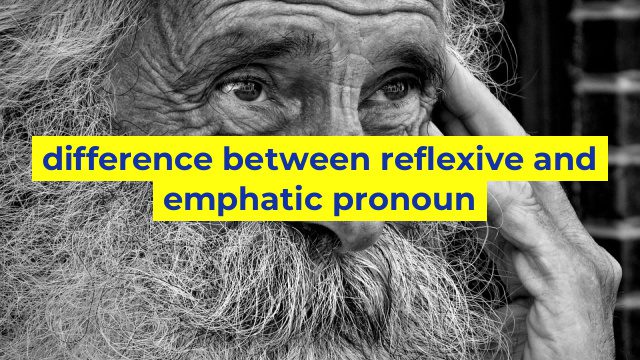Reflexive Pronoun vs. Emphatic Pronoun: What’s the Difference?
Introduction
In English grammar, pronouns serve as substitutes for nouns. They help make communication more concise and reduce redundancy within language. Reflexive pronouns and emphatic pronouns are two types of pronouns that perform distinct roles. Many people get confused between these two concepts. In this article, we will explore the difference between reflexive and emphatic pronouns.
Reflexive Pronoun
A reflexive pronoun is a pronoun that ends in “-self” or “-selves” and reflects back to the subject. We use reflexive pronouns when the subject and object in a sentence are the same person or thing.
For example: “I taught myself to cook.”
In this sentence, “myself” is a reflexive pronoun because it reflects the subject “I.” Notice that without “myself,” the sentence would be “I taught to cook,” which doesn’t make sense.
Emphatic Pronoun
An emphatic pronoun is a pronoun that we use to provide emphasis and show stress. Emphatic pronouns are generally used to highlight or emphasize the importance of a particular pronoun or to add intensity to a statement.
For example: “I myself completed the project.”
In this sentence, “myself” is an emphatic pronoun as it emphasizes the importance of the subject “I.” It is not a reflexive pronoun since the subject and object are not the same.
Differences between Reflexive and Emphatic Pronoun
The primary difference between a reflexive pronoun and an emphatic pronoun is their function within a sentence.
A reflexive pronoun reflects back to the subject in a sentence where subject and object are the same. In contrast, an emphatic pronoun signifies emphasis and stress on a particular pronoun to make it more intense.
Another significant difference is the structure of these pronouns. Reflexive pronouns end with “self” or “selves,” whereas emphatic pronouns are the same pronouns but with the addition of the word “own” after it.
Conclusion
In conclusion, reflexive pronouns and emphatic pronouns are two different kinds of pronouns that are critical to understanding English grammar. Reflexive pronouns reflect back to the subject in a sentence where subject and object are the same, while emphatic pronouns are used only to add emphasis and intensity to a particular pronoun. Understanding the difference between them can help you write and communicate more accurately and clearly in English.
Table difference between reflexive and emphatic pronoun
| Reflexive Pronoun | Emphatic Pronoun |
|---|---|
| Reflexive pronouns refer to the subject of the sentence and are used when the subject performs an action on itself. | Emphatic pronouns are used to emphasize a noun or pronoun and give importance to it. |
| Examples: myself, herself, himself, themselves, ourselves, itself, yourself | Examples: myself, yourself, himself, herself, themselves, ourselves, itself |
| They are used in sentences where the subject and object are the same. | They are used for emphasis on a specific noun or pronoun in a sentence. |
| Examples: She hurt herself while playing. | Examples: I myself will take care of the situation. |
| Reflexive pronouns end with “-self” or “-selves”. | Emphatic pronouns can be used with or without the noun or pronoun. |
| They are used in sentences such as “I hurt myself”, “She admires herself”, and “The cat groomed itself”. | They are used in sentences such as “I myself will do it”, “He bought the car himself”, and “She herself made the cake” |


